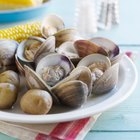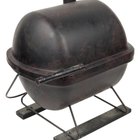
Some foods, such as fresh fruit, are innately appealing even to a casual observer. Others, such as organ meats, snails or octopus, have an "ick" factor that can deter many diners. It's unfortunate, because all of those delicacies -- and many others -- are delicious when prepared properly, and preparation is often easier than novices expect. For example, most octopus is sold already cleaned and ready to cook.
About Cephalopods
Octopus, squid and their cousins are known to scientists as cephalopods, which could be translated loosely as "a head with feet." They share an ancestry with more conventional shellfish, such as clams and oysters, though only the nautilus retains its external shell. Cuttlefish and squid retain a residual shell inside their soft bodies, while in the octopus it has completely disappeared. Cephalopods are just as sweetly flavorful as lobsters and crabs, but are trickier to cook because of their anatomy. Their muscle fibers are especially long and strong to compensate for the lack of a supportive shell or skeleton. That makes them naturally tough and chewy.
Cleaning the Octopus
Most octopus available at retail stores and fishmongers are already cleaned, and are ready to be cooked. If you've purchased your octopus fresh and whole, cleaning is relatively quick. Scrub the tentacles with a soft brush under cold running water if they show any signs of grit or debris. Usually this isn't necessary. Sever the octopus' mantle just below the eyes, then make a second cut just above the eyes to leave the edible portion. Discard the eye section, and carefully pull out the ink sac and entrails from the mantle. In the middle of the tentacle section you'll find the mouth opening and the tiny bill. Cut around it with a paring knife, and push it out.
The Skin
The only further preparation the tentacles may need is skin removal, if you choose to do so. The skin is entirely edible, with a gelatinous texture that lends richness to the liquid it's cooked in. If you choose to grill the tentacles, the skin will be all but undetectable when you're done. However, if you want to skin your octopus for aesthetic reasons, it's easiest to do after it has been cooked tender.
Preparing the Octopus
Very small octopus can be grilled for just a few minutes, too short a time for them to toughen. Most octopus require longer, slower cooking, which tightens up the muscle tissues but then tenderizes them again over time. The octopus should be simmered gently in water or a more flavorful liquid, such as wine or fish stock. Most require about 15 to 20 minutes of simmering per pound, but there's a lot of individual variation. When you can insert the tip of a knife easily into the thickest section at the top of the tentacles, it's done. Cool the octopus and rub the skin away with a clean towel, if you prefer. It can now be served cold, marinated for a salad or quickly grilled, as directed in your favorite recipe.
Related Articles

How to Cook a Fresh Perch
Can You Freeze Nopales?

Types of Edible Clams

Can You Eat the Inside of a Squid?

How to Cook Fresh Brook Trout

How to Devein Tiger Prawns

Can You Eat the Skin on Grilled Trout?

Difference Between Boiled & Grilled ...

How to Fillet a Goliath Grouper

Fastest Way to Clean & Freeze Catfish

How to Cook Jonah Crabs

How to Cauterize Skin Tags

How to Clean a Sucker Fish

How to Boil Conch in the Shell
How to Grill Chayote Squash

Peeling the Spiny Chayote Squash

How to Clean Scallops

How to Remove Whelk Shells

How to Cook Squab

How to Cook Mackerel in an Oven
References
- On Food and Cooking: The Science and Lore of the Kitchen; Harold McGee
- On Cooking: A Textbook of Culinary Fundamentals; Sarah Labensky, et al.
- The New York Times: Embracing the Octopus, Tenderly
Writer Bio
Fred Decker is a trained chef and prolific freelance writer. In previous careers, he sold insurance and mutual funds, and was a longtime retailer. He was educated at Memorial University of Newfoundland and the Northern Alberta Institute of Technology. His articles have appeared on numerous home and garden sites including GoneOutdoors, TheNest and eHow.
Photo Credits
John Foxx/Stockbyte/Getty Images